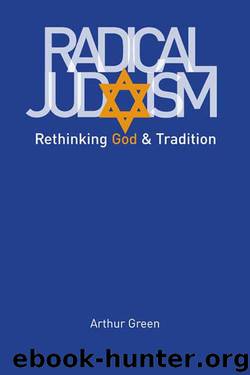Radical Judaism: Rethinking God and Tradition (The Franz Rosenzweig Lecture Series) by Green Arthur

Author:Green, Arthur [Green, Arthur]
Language: eng
Format: mobi, epub
Publisher: Yale University Press
Published: 2010-02-17T16:00:00+00:00
Sinai and Covenant
When we approach Sinai, however, we stand directly in the face of Israel's myth: its faith in its uniqueness and its singular covenant with God. How can a religious universalist live with these, and how can one imagine a Judaism without them? I remain an affirmer of both Sinai and covenant, but in very carefully defined ways, including both restriction and expansion of their meaning.
We Jews began our life together as a sacred community by an act of covenantal engagement. That is the original community of Israel, gathered at the base of Mount Sinai, a gathering that takes place throughout all eternity, one at which each of us (including all who choose to join the people Israel) is ever present. This is when we become “a kingdom of priests, a holy nation” (Ex. 19:6). Priesthood makes no sense without a laity, in this case one that includes the entire human family. The task of the priest is to teach and to serve in such ways as to help others come close to God. The teaching this family of nations is to receive (not only from us) needs to be a universal one, applicable to them all. Its most basic principles are two: all of being is one in Y-H-W-H, and every person is the image of God. This is our message, the reason we continue to exist. All the rest is commentary.
As a religious Jew, I remain fully committed to this priesthood. I understand, in the language of tradition, that “Israel stand under oath since Mount Sinai.”50 The covenant is one of joy as well as burden. Sinai is the moment in which each heart leaps forward and says na'aseh ve-nishma’ (“Let us do! Let us hear!” [Ex. 24:7]), committing us to live in response to the Word even before it is fully uttered. Because that covenantal moment is so central to the life of Judaism, I need to offer some clear statement as to how I understand it in the context of the theology I am proposing.
First I need to remind us that we are living within the story, dwelling in the land of myth. I make no claim for the literal historicity of Sinai. Like the seven-day Creation, it is a sacred tale around which our lives are woven, representing a truth that resides in the realm of myth and symbol, a deeper truth than that of history, but one that should not be confused with it. Even though we are talking within the story, however, some distinctions can be made as to how we understand it and are committed to it. The key chapter that describes Sinai as covenant is Exodus 24, where the covenantal ritual is described in a few verses inserted within the account of Moses’ and the elders’ ascent and vision at the top of the mount. Moses creates a very powerful ritual of binding, in which he takes the blood-offering of sacrificial bullocks and sprinkles it, half on the altar, representing God, and half on the assembled throng of Israel.
Download
Radical Judaism: Rethinking God and Tradition (The Franz Rosenzweig Lecture Series) by Green Arthur.epub
This site does not store any files on its server. We only index and link to content provided by other sites. Please contact the content providers to delete copyright contents if any and email us, we'll remove relevant links or contents immediately.
| Hebrew Bible (Old Testament) | Talmud |
| Torah | Zohar |
The Secret Power of Speaking God's Word by Joyce Meyer(2974)
Man's Search for Meaning by Viktor E. Frankl(2605)
Mckeown, Greg - Essentialism: The Disciplined Pursuit of Less by Mckeown Greg(2386)
MOSES THE EGYPTIAN by Jan Assmann(2373)
Devil, The by Almond Philip C(2282)
The Complete Dead Sea Scrolls in English (7th Edition) (Penguin Classics) by Geza Vermes(2235)
Unbound by Arlene Stein(2229)
I Capture the Castle by Dodie Smith(1985)
Schindler's Ark by Thomas Keneally(1829)
The Invisible Wall by Harry Bernstein(1767)
The Gnostic Gospel of St. Thomas by Tau Malachi(1738)
The Bible Doesn't Say That by Dr. Joel M. Hoffman(1652)
The Secret Doctrine of the Kabbalah by Leonora Leet(1574)
Political Theology by Carl Schmitt(1543)
The Jewish State by Theodor Herzl(1506)
A History of the Jews by Max I. Dimont(1485)
The Dead Sea Scrolls Bible by Martin G. Abegg(1470)
The Book of Separation by Tova Mirvis(1458)
Oy!: The Ultimate Book of Jewish Jokes by David Minkoff(1334)
